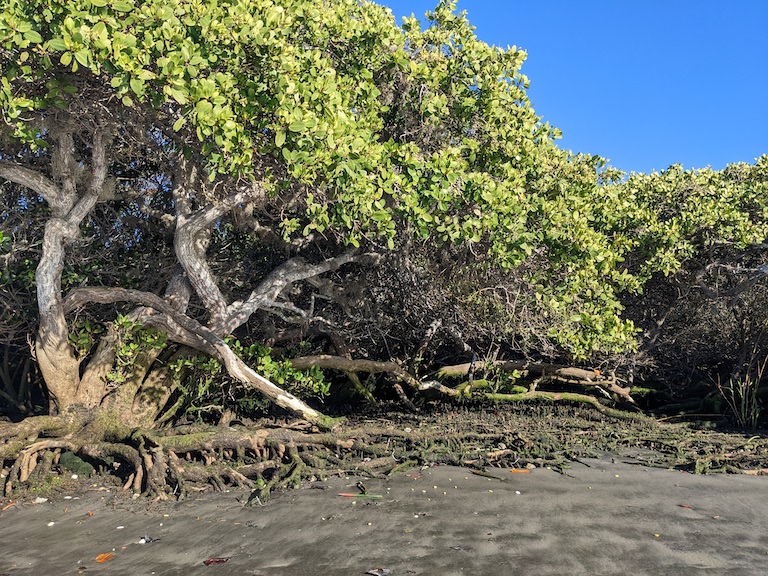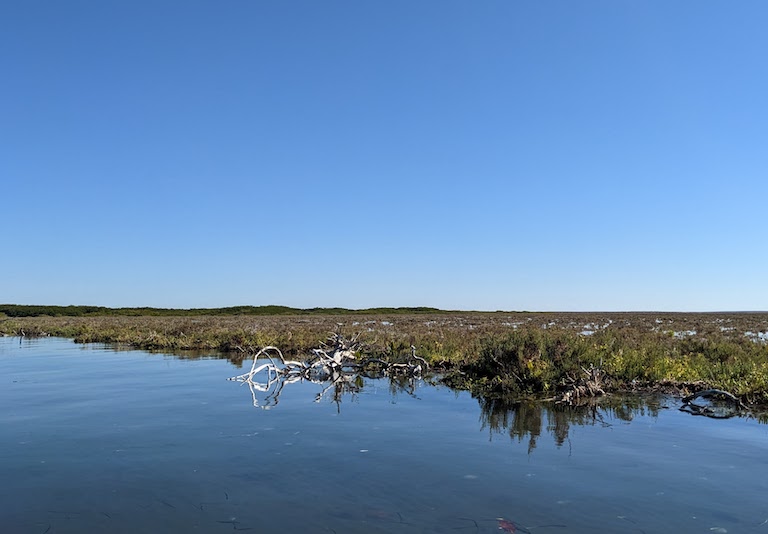- Mangroves are unique forests adapted to live along the coasts in mostly tropical and subtropical areas of the world.
- Mangroves are in danger as they are cleared to make room for farms, mines, and other human developments.
- Mangroves provide a bevy of important ecosystem services such as flood and erosion control and greenhouse gas storage, and they provide habitat for many species.
- Below are some of the most notable mangrove news items of 2022.
Not quite aquatic but not fully terrestrial, mangrove forests are uniquely adapted to inhabit the interface between land and sea in the warmer parts of the world. Compared to the vast boreal forests of the north and inland rainforests of the tropics, mangroves are tiny, perched mostly in thin strips along intertidal zones. But research is progressively uncovering their outsize importance to communities both human and ecological: they mitigate climate change as well as protect against its effects; they act as nurseries for fish stocks; they buffer storm swells and ward against erosion; they neutralize pollution.
The following is a look at some of the most notable mangrove developments of 2022.

A freshwater surprise
While mangroves are typically found in saltwater environments, there are a handful of known exceptions. Cuba and the U.S. state of Florida both harbor freshwater mangroves, and in 2021 a mangrove forest was discovered some 170 kilometers (106 miles) inland in southern Mexico.
A study published in 2022 in the journal Current Biology revealed the discovery of another such forest, this one tucked away in eastern Brazil near where the Amazon River meets the Pacific Ocean — and is the first documented instance of a freshwater mangrove in a coastal or delta region.

A unique relationship
Mangroves inhabiting the saltier side of the spectrum are sometimes found growing amidst corals, but this association is not well understood by the scientific community. A study published in PLOS One in June 2022 took a closer look at coexisting mangrove-coral (CMC) habitats, finding that they provide homes for some 130 species of coral and are likely more common than we think, particularly in the tropical Pacific.
Both coral and mangrove ecosystems provide vital habitat for many other marine species — and both are particularly vulnerable to climate change and other human impacts — so pinpointing where CMCs exist and figuring out how they function “is essential [for determining] the role CMC habitats will serve for coral survival and protecting the health of our oceans,” study co-author Jennifer Wright said in a media release.

A pollution solution
Living on the knife’s edge between land and sea puts mangroves at risk from environmental change on both fronts. But a study published recently in the journal Science of the Total Environment found mangroves may be tougher than previously assumed when it comes to heavy metal pollution.
The study’s authors found that grey mangroves (Avicennia marina) near the southern Australian city of Adelaide are tolerating high levels of lead, zinc, arsenic, cadmium and copper in sediment contaminated by a coastal smelter, without sustaining damage themselves or transferring contamination to the animals that live within them. By trapping metals deep in the soil, mangroves provide yet another ecosystem service to both coastal habitats and human communities — and further highlights the importance of protecting them.
Reduced ocean salinity could affect future generations
Unlike most trees, mangrove species reproduce through a process called vivipary in which their seeds germinate while still attached to the parent plant. The seedlings, called propagules, drop into the water and float along with ocean currents and tides to coasts unknown where, with luck, they take root and begin the cycle anew. But a study published in early 2022 in the journal Nature Climate Change finds that climate change may pose a hurdle to seafaring propagules.

According to the study’s findings, shifts in ocean temperature and salinity will lead to a change in water density, particularly in the Indo-Pacific region, which is the world’s hotspot of mangrove diversity. The authors warn that as water density drops, mangrove propagules may no longer be able to float, which could affect their ability to reproduce and disperse.
Economic development now helps mangroves
Between 1996 and 2020, the world lost 5,245 square kilometers (2,025 square miles) — or about 3.5% — of its mangrove forests. A report produced by NGO consortium Global Mangrove Alliance and released in 2022 shows mangrove loss has been trending downward globally in recent years. But areas of mangrove still continue to be cleared, with the highest levels of loss in Southeast Asia, Central America and the Caribbean.

Most mangrove loss has been driven by deforestation and land conversion for aquaculture, agriculture, and urban development. But a 2022 study published in the journal Nature Communications finds the situation may be shifting. The researchers found that as an area becomes more economically developed, mangrove deforestation drops off.
“This is potentially because of increased wealth and education and improved agricultural productivity, which would ultimately reduce economic pressure,” study co-author Valerie Hagger said in a press release.
The study also found that community forestry projects were generally effective at reducing mangrove deforestation.
Brazil’s mangrove carbon revealed
Mangroves are carbon storage powerhouses, pound-for-pound sequestering more carbon than tropical rainforest. This means that when a mangrove is cleared, it doesn’t just destroy habitat — it contributes to global warming.
But exactly how much carbon mangroves store per region remains a mystery. A study published in early 2022 in Frontiers in Forests and Global Change set to work quantifying just how much carbon is trapped by Brazil’s mangroves.

The study’s findings indicate the country’s mangroves hold 8.5% of the global mangrove carbon stock, and 2.2 and 4.3 times more carbon in the top meter of soil than any other Brazilian biome. But its authors warn that many of Brazil’s mangroves aren’t protected, and that the transition area directly inland from mangroves — where mangroves will likely retreat as sea levels rise — isn’t afforded any protection under Brazilian law.
Storing carbon from the Stone Age
In addition to sequestering a lot of carbon, research suggests some mangroves have been storing it for much longer than we thought. A 2022 study published in Marine Ecology Progress Series dug (carefully) into mangroves in Mexico’s Baja California peninsula, and discovered a layer of carbon-rich sediment called peat that extended 10 feet (3 meters) down, the deepest layers of which are an estimated 5,000 years old.
“These sites are protecting carbon that has been there for millennia,” study co-author Matthew Costa said in a media release. “Disturbing them would cause a carbon emission that we wouldn’t be able to repair any time soon.”

Small impacts result in big emissions
In a global analysis published in Cell Press in October 2022, researchers found that carbon storage is significantly higher in seagrass meadows and mangroves forests that were protected, and in areas where sediment wasn’t disturbed by trawling fishing techniques.
“Partial or full degradation of mangroves and seagrass both resulted in similar decreases of sequestered carbon, indicating that even low levels of human impact result in important carbon emissions,” the authors write.
Cost-effective flood control
In addition to keeping climate change at bay by keeping carbon out of the atmosphere, mangroves can shield coastal communities from its impacts by acting as natural barriers to waves and storm surges. A study published May 2022 in the journal Ecosystem Services found that safeguarding and restoring mangroves and coral reefs could be a cost-effective way to reduce coastal flooding in more than 20 countries across the Caribbean.
Increased protection commitments in the Indian Ocean
As researchers pull back the curtain on mangroves’ carbon storage and flood mitigation superpowers, scientists and activists are clamoring to add them to the arsenal against global climate change. In some areas of the tropics, governments are responding in suit.
In November 2022, 10 nations in the Western Indian Ocean committed to create a network of marine conservation areas to hasten progress toward the goal of protecting 30% of their ocean area by 2030. Less than 10% of the marine expanse in this region is currently protected. The initiative is aimed at coral reefs and seagrass meadows, in addition to mangroves.

Promise and problems in Indonesia
A study published in Environmental Research Letters found that fully protecting Indonesia’s remaining peatlands and mangroves will propel the country to its goal of cutting greenhouse gas emissions by the end of the decade. More specifically, its findings reveal that enacting a moratorium on all wetland deforestation could increase carbon sequestration and storage by up to 1,001 million metric tons of carbon dioxide equivalent per year — double the government’s emissions reduction targets from forestry and other land use sectors to which Indonesia committed when it signed on to the Paris climate agreement.
However, urging environmental safeguards is one thing; enacting and enforcing them is another matter entirely. Indonesia has recorded mixed progress in its dual programs aimed at restoring 1.2 million hectares (3 million acres) of degraded peatlands and 600,000 hectares (1.5 million acres) of degraded mangroves by 2024, with less than 6% of mangrove areas restored compared to 25% of peatlands. Officials and experts told Mongabay that a major hurdle for mangrove restoration and protection is the continued clearing of mangroves to establish shrimp and fish farms.
“There’s still a lot of work that we have to do until 2024, considering that our target is 600,000 hectares,” Satyawan Pudyatmoko, deputy for planning and evaluation for the Peatland and Mangrove Restoration Agency, said at an online event.
Banner image: The author poses/hides in a mangrove at low tide. Image by Morgan Erickson-Davis.
Citations:
Costa MT, Ezcurra E, Aburto-Oropeza O, Maltz M, Arogyaswamy K, Botthoff J, Aronson E (2022) Baja California Sur mangrove deep peat microbial communities cycle nitrogen but do not affect old carbon pool. Mar Ecol Prog Ser 695:15-31. https://doi.org/10.3354/meps14117
Hagger, V., Worthington, T.A., Lovelock, C.E. et al. Drivers of global mangrove loss and gain in social-ecological systems. Nat Commun 13, 6373 (2022). https://doi.org/10.1038/s41467-022-33962-x
Novita, N., Subarno, Lestari, N. S., Anshari, G. Z., Lugina, M., Yeo, S., Malik, A., … Ellis, P. (2022). Natural climate solutions in Indonesia: Wetlands are the key to achieve Indonesia’s national climate commitment. Environmental Research Letters, 17(11). doi:10.1088/1748-9326/ac9e0a
Rovai, A. S., Twilley, R. R., Worthington, T. A., & Riul, P. (2022). Brazilian mangroves: Blue carbon hotspots of national and global relevance to natural climate solutions. Frontiers in Forests and Global Change, 4. doi:10.3389/ffgc.2021.787533
Stewart HA, Wright JL, Carrigan M, Altieri AH, Kline DI, et al. (2022) Novel coexisting mangrove-coral habitats: Extensive coral communities located deep within mangrove canopies of Panama, a global classification system and predicted distributions. PLOS ONE 17(6): e0269181. https://doi.org/10.1371/journal.pone.0269181
Van der Stocken, T., Vanschoenwinkel, B., Carroll, D. et al. Mangrove dispersal disrupted by projected changes in global seawater density. Nat. Clim. Chang. 12, 685–691 (2022). https://doi.org/10.1038/s41558-022-01391-9
Feedback: Use this form to send a message to the editor of this post. If you want to post a public comment, you can do that at the bottom of the page.
